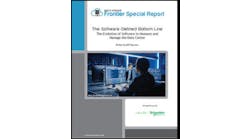Wonder Valley and the Great AI Pivot: Kevin O’Leary’s Bold Data Center Play
Data Center World 2025 drew record-breaking attendance, underscoring the AI-fueled urgency transforming infrastructure investment. But no session captivated the crowd quite like Kevin O’Leary’s electrifying keynote on Wonder Valley—his audacious plan to build the world’s largest AI compute data center campus.
In a sweeping narrative that ranged from pandemic pivots to stranded gas and Branson-brand inspiration, O’Leary laid out a real estate and infrastructure strategy built for the AI era.
A Pandemic-Era Pivot Becomes a Case Study in Digital Resilience
O’Leary opened with a Shark Tank success story that doubled as a business parable. In 2019, a woman-led startup called Blueland raised $50 million to eliminate plastic cleaning bottles by shipping concentrated cleaning tablets in reusable kits. When COVID-19 shut down retail in 2020, her inventory was stuck in limbo—until she made an urgent call to O’Leary.
What followed was a high-stakes, last-minute pivot: a union-approved commercial shoot in Brooklyn the night SAG-AFTRA shut down television production. The direct response ad campaign that resulted would not only liquidate the stranded inventory at full margin, but deliver something more valuable—data.
By targeting locked-down consumers through local remnant TV ad slots and optimizing by conversion, Blueland saw unheard-of response rates as high as 17%. The campaign turned into a data goldmine: buyer locations, tablet usage patterns, household sizes, and contact details. Follow-up SMS campaigns would drive 30% reorders.
“It built such a franchise in those 36 months,” O’Leary said, “with no retail. Now every retailer wants in.” The lesson? Build your infrastructure to control your data, and you build a business that scales even in chaos.
This anecdote set the tone for the keynote: in a volatile world, infrastructure resilience and data control are the new core competencies.
The Data Center Power Crisis: “There Is Not a Gig on the Grid”
O’Leary didn’t mince words about the current state of power availability. “There is not a gig on the grid anywhere in any state today,” he stated. Demand is outstripping the ability of utilities and regulators to respond. “Anybody that tells me otherwise is full of it.”
He painted a stark contrast between hyperscaler ambitions and the grid’s reality. “We used to get 500-megawatt commitments from states—but the queue was seven years long. You can’t build a business on a seven-year promise.”
O’Leary emphasized that the speed of the AI boom is incompatible with legacy utility planning cycles. He quoted Amazon CEO Andy Jassy, who had said just 48 hours prior: “We have such high demand right now for AWS and AI growth is so significant that we don’t see any attenuation.”
“Every time Amazon lights up a region, it gets swallowed up by training runs in 30 days,” O’Leary added. “We are not building fast enough.”
Of course, Wall Street didn’t get the memo. Just days after O’Leary’s keynote, a report from Wells Fargo suggested AWS may actually be seeing AI growth slowing, with capex falling short of expectations and signs of digestion among hyperscale buyers.
Whether that’s a blip or a broader recalibration, O’Leary's argument wasn’t buying it: The momentum, he contended, still lies with those who can scale off-grid and out front.
Nvidia’s 12-Month Upgrade Cycle and the CapEx Crunch
AI infrastructure isn’t just power-hungry—it’s refresh-hungry. O’Leary noted that GPU stacks are now refreshing every 12 to 18 months. “Nvidia’s upscaling cycle used to be 18 months. I think within a year or two, it’ll be 12.”
This isn’t just a technical challenge. It’s a budgetary earthquake. “You’re going to take those stacks and refresh them every 12 to 18 months. That’s huge CapEx,” he said. “So every state has to have a tax holiday on that wherever you’re building. And they’re getting the joke—they’re doing it.”
He also noted how this rapid cycle intensifies site selection and vendor risk. “You can’t just pick a site and hope—it has to be engineered to turn over gear at scale.”
The core message: AI infrastructure isn’t just about servers—it’s about structural agility in policy, planning, and procurement.
Wonder Valley: A Unicorn in the Forest
To address these compounding demands, O’Leary unveiled what he called the “unicorn of North America”—Wonder Valley, a 7,000-acre AI compute park in Alberta. Entirely off-grid, Wonder Valley will be powered by stranded natural gas, a massively underutilized resource that Alberta holds in abundance.
“This is the single largest AI compute data center park on Earth,” O’Leary declared. “Completely independent, with enough water, land, and fiber.”
He described the deal structure as a joint venture between energy, capital, and infrastructure players. “We’re not just building data centers—we’re building energy platforms around AI.”
O’Leary also detailed how Wonder Valley draws inspiration from Richard Branson, who once advised him, “Why not call everything ‘Wonder’? It worked for Virgin.” Now, O’Leary is branding everything from Wonder Valley to Wonder Capital, using the theme to cross-pollinate visibility and value.
“This isn’t just a project—it’s a platform,” he emphasized.
From New York to Norway: Lessons in Global Energy Policy
O’Leary’s path to Wonder Valley was one of lessons learned. His first project began in upstate New York, where policy and permitting delays forced him to abandon the site. “I don’t invest in New York anymore,” he said bluntly.
Instead, he shifted the operation to Norway, where a combination of hydropower and favorable energy policy helped the site flourish. That project has since doubled in size, and serves as a template for sustainable builds.
His teams also explored nuclear power in Finland, further sharpening their playbook for energy-resilient builds. “We learned to de-risk through energy first, not real estate.”
“These are smaller projects,” he said, “but they gave us our engineering chops.”
The Playbook: Power Deals, Turbine Deliveries, and Government Cooperation
What makes Wonder Valley replicable? It’s not just the land or gas—it’s the ecosystem. O’Leary stressed the importance of community infrastructure: “You need people, you need a polytechnical institute, you need a hospital, a dry cleaner, parking—you need all of that.”
He spoke in detail about turbine procurement as a bottleneck: “There’s a massive problem in turbine delivery. If you want to finance $20 billion worth of turbines, you better have a power deal before the first brick is laid.”
To solve this, O’Leary’s team has created a three-legged stool: vendor consortia, power strategy, and local alignment. “These projects can’t happen without state and local governments who get the joke.”
He also noted Wonder Valley has secured buy-in from First Nations and Alberta’s provincial leadership. “If you don’t have political cover, you don’t have a project.”
Two Models: Build-to-Suit vs. Lease-Back Hyperscaler Preferences
O’Leary outlined two paths for hyperscaler participation. Some, like G42, want to buy the land and build once the permitting and power are secured. Others prefer a lease-back model, taking full occupancy of a prebuilt facility in a 5-9s configuration.
“As a developer, you need to be ready for both,” he said. “You need to aggregate land, power, and water, but also know how to monetize through either model.”
He highlighted how structuring pre-leases around power and modularity helps derisk capital. “No one’s waiting 36 months anymore. You need to have capacity in the ground ready to flip.”
This bifurcation is reshaping how developers approach risk, capital structure, and long-term value creation.
Conclusion: The Patriots Playbook for Data Centers
With Wonder Valley, O’Leary isn’t just building one site—he’s creating a repeatable playbook. “When Brady was quarterback,” he quipped, “you just move the Patriots from location to location. That’s what Wonder Valley is.”
He’s now scouting 6,000+ acre sites with similar profiles: stranded gas, supportive governments, and willing communities.
He closed by challenging the audience: “There’s $1.6 trillion of AI infrastructure coming in the next decade. You’re either building it—or you’re watching it.”
In a year of historic industry momentum, O’Leary’s keynote at Data Center World 2025 was a definitive moment. Infrastructure is no longer background—it’s center stage, and the next decade will be shaped by who can build it, power it, and scale it fast enough to meet AI’s unrelenting demand.
At Data Center Frontier, we talk the industry talk and walk the industry walk. In that spirit, DCF Staff members may occasionally use AI tools to assist with content. Parts of this article were created with help from OpenAI's GPT4.
Keep pace with the fast-moving world of data centers and cloud computing by connecting with Data Center Frontier on LinkedIn, following us on X/Twitter and Facebook, as well as on BlueSky, and signing up for our weekly newsletters using the form below.

Matt Vincent
A B2B technology journalist and editor with more than two decades of experience, Matt Vincent is Editor in Chief of Data Center Frontier.





